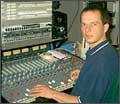Introduction to Audio

This beginner-level tutorial covers the basics of audio production. It is suitable for anyone wanting to learn more about working with sound, in either amateur or professional situations. The tutorial is five pages and takes about 20 minutes to complete.
What is "Audio"?
Audio means "of sound" or "of the reproduction of sound". Specifically, it refers to the range of frequencies detectable by the human ear — approximately 20Hz to 20kHz. It's not a bad idea to memorise those numbers — 20Hz is the lowest-pitched (bassiest) sound we can hear, 20kHz is the highest pitch we can hear.
Audio work involves the production, recording, manipulation and reproduction of sound waves. To understand audio you must have a grasp of two things:
- Sound Waves: What they are, how they are produced and how we hear them.
- Sound Equipment: What the different components are, what they do, how to choose the correct equipment and use it properly.
Fortunately it's not particularly difficult. Audio theory is simpler than video theory and once you understand the basic path from the sound source through the sound equipment to the ear, it all starts to make sense.
Technical note: In physics, sound is a form of energy known as acoustical energy.
The Field of Audio Work
The field of audio is vast, with many areas of specialty. Hobbyists use audio for all sorts of things, and audio professionals can be found in a huge range of vocations. Some common areas of audio work include:
- Studio Sound Engineer
- Live Sound Engineer
- Musician
- Music Producer
- DJ
- Radio technician
- Film/Television Sound Recordist
- Field Sound Engineer
- Audio Editor
- Post-Production Audio Creator

In addition, many other professions require a level of audio proficiency. For example, video camera operators should know enough about audio to be able to record good quality sound with their pictures.
Speaking of video-making, it's important to recognise the importance of audio in film and video. A common mistake amongst amateurs is to concentrate only on the vision and assume that as long as the microphone is working the audio will be fine. However, satisfactory audio requires skill and effort. Sound is critical to the flow of the programme — indeed in many situations high quality sound is more important than high quality video.
Most jobs in audio production require some sort of specialist skill set, whether it be micing up a drum kit or creating synthetic sound effects. Before you get too carried away with learning specific tasks, you should make sure you have a general grounding in the principles of sound. Once you have done this homework you will be well placed to begin specialising.
The first thing to tackle is basic sound wave theory...
Next Page: How Sound Waves Work